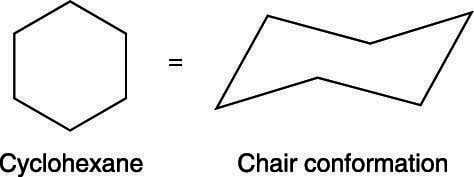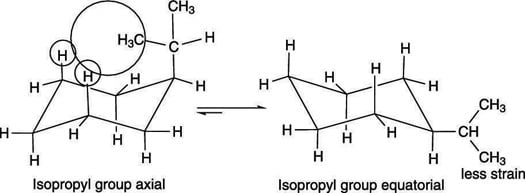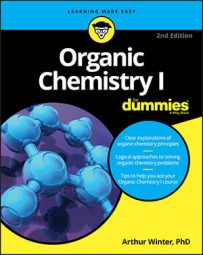
The chair conformation of cyclohexane
The importance of drawing chairs
Many students find that drawing chairs can be somewhat difficult at first, but mastering the correct drawing of this conformation is essential for your success in organic chemistry. To begin, start by drawing two lines that are parallel to each other but not perfectly horizontal, as shown here. Next, add a downward-pointing V tip to one end (this is the tail of the chair). Finally, add an upward-pointing V tip to the other end (this is the nose of the chair).
The steps involved in drawing the chair conformation of cyclohexane
Axial hydrogens, equatorial hydrogens
A cyclohexane chair contains two kinds of hydrogens — axial hydrogens and equatorial hydrogens. Axial hydrogens are those hydrogens that stick straight up or straight down parallel to an imaginary axis through the chair; equatorial hydrogens are hydrogens that stick out along the equator of the chair. Both types are shown here.
The axial and equatorial hydrogens on cyclohexane
In drawing the hydrogens on a chair cyclohexane, it's often easiest to draw the axial hydrogens first. At any point on the chair that sticks up, put the axial hydrogen sticking straight up; at any point on the chair that sticks down, draw the axial hydrogen straight down. After the axial hydrogens are drawn, adding in the equatorial hydrogens around the equator of the chair is a fairly straightforward task.
The ring flip
At room temperature, cyclohexane doesn't stay in one-chair conformation, but rapidly interconverts into an alternative chair conformation with a ring flip, shown here.
The ring flip of cyclohexane
When a ring flip doesn't change the molecule
With unsubstituted cyclohexane (a cyclohexane that has only hydrogens attached to it), undergoing a ring flip doesn't change the molecule. With substituted cyclohexanes, however, the two chair conformers may not be identical. For example, isopropylcyclohexane is shown here. One chair conformer puts the isopropyl group in the axial position. After undergoing a ring flip, the isopropyl becomes equatorial.
The chair conformers of isopropylcyclohexane
Ring flips change all axial positions to equatorial and all equatorial positions to axial.
These two conformers are not identical, and they don't have the same energy. When a large group is axial, the large group invades the space of the hydrogens on carbons two positions away, introducing 1,3-diaxial strain. This interaction increases the energy of the axial conformer. Therefore, as a rule, large groups prefer to be equatorial because this conformation has no 1,3-diaxial strain — as shown in the figure, the right-pointing arrow is longer, indicating the direction of the equilibrium favors the more stable chair conformation.
